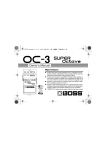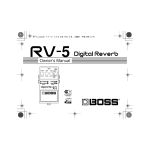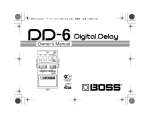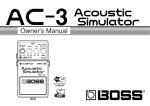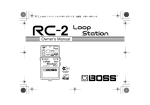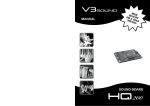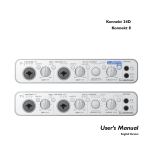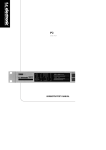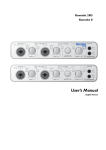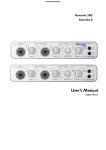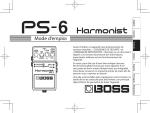Download Roland SYB-5 Owner`s manual
Transcript
Owner’s Manual AC DC AC & BATTERY POWERED FET Thank you, and congratulations on your choice of BOSS SYB-5 Bass Synthesizer. Before using this unit, carefully read the sections entitled: “USING THE UNIT SAFELY” and “IMPORTANT NOTES” (separate sheet). These sections provide important information concerning the proper operation of the unit. Additionally, in order to feel assured that you have gained a good grasp of every feature provided by your new unit, this manual should be read in its entirety. The manual should be saved and kept on hand as a convenient reference. A battery is supplied with the unit. The life of this battery may be limited, however, since its primary purpose was to enable testing. Copyright © 2004 BOSS CORPORATION All rights reserved. No part of this publication may be reproduced in any form without the written permission of BOSS CORPORATION. 2 Main Features ● This compact effect creates a variety of bass synthesizer sounds. ● This unit features a dual-system bass synthesizer, which creates sounds in two different ways, and 11 modes to produce a variety of sound characteristics. ● Features a mode that the changes the filter, synchronizing it with the internal LFO. This is useful for creating techno sounds. ● One mode uses an all-pass filter, allowing you to create a whole new synth sound that has a sense of depth and motion. ● The Hold function allows you to output effect sounds (synthesizer sound) continuously while you keep the pedal down. (This applies when the Mode is set to 1–9.) ● In the stereo output mode, the effect sound (synthesizer sound) and direct sound can be output separately. ● The SYB-5 not only works with four-string basses, it is compatible with five- and six-string basses as well (the range for detecting pitch is A0–C5). ● Equipped with Expression/Control jack. You can connect an expression pedal (the optional Roland EV-5) and use it to switch the bass synth sounds. 3 Panel Descriptions 1. AC Adaptor Jack fig.01 1 2 Accepts connection of an AC Adaptor (optionally available BOSS PSA-series). By using an AC Adaptor, you can play without being concerned about how much battery power you have left. * As soon as you connect the AC adaptor, the unit is turned on. 3 4 5 * If there are batteries in the unit while an AC adaptor is being used, normal operation will continue should the line voltage be interrupted (power blackout or power cord disconnection). * Use only the specified AC adaptor (PSA-series). 2. CHECK Indicator 6 7 4 This indicator shows whether an effect is ON/OFF, and also doubles as the Battery Check indicator. The indicator lights when an effect is ON. Panel Descriptions * If this indicator goes dim or no longer lights while an effect is ON, the battery is near exhaustion and should be replaced immediately. For instructions on changing the battery, refer to “Changing the Battery” (p. 18). * The CHECK indicator shows whether the effect is being applied or not. It does not indicate whether the power to the device is on or not. 3. OUTPUT A (MONO) Jack, OUTPUT B Jack The output jacks are used to connect the unit to amplifiers or other devices. * For mono output, use OUTPUT A (MONO). * For stereo use: Output A: Only the processed signal is output. Output B: Only the dry signal is output. 4. INPUT Jack This jack accept input signal coming from a bass. * When running the unit on battery power, the INPUT jack as power switch. Power to the unit is turned on when you plug into the INPUT jack; the power is turned off when the cable is unplugged. Be sure to disconnect a cord plugged into the INPUT jack when not using this effects device. When the AC adaptor is used, the power remains on at all times, and this function is disabled. 5. EXP Jack Connect an expression pedal (the optional Roland EV-5) here. You can then use the expression pedal to change the bass synth sound. * For more details, refer to “Using the EXP Jack” (p. 15). 5 Panel Descriptions 6. Pedal Switch This switch turns the effects on/off. This is also used for the Hold function. fig.02 8 9 10 11 12 13 7. Thumbscrew When this screw is loosened, the pedal will open, allowing you to change the battery. * For instructions on changing the battery, refer to “Changing the Battery” (p. 18). 8. EFFECT (Effect Level) Knob This adjusts the output level of the effect sound (synth sound). The volume of the effect sound increases as you turn the knob clockwise. * Rotating this knob fully counterclockwise will eliminate the effect sound. 6 Panel Descriptions 9. DIRECT (Direct Level) Knob This adjusts the output level of the direct sound. The volume of the direct sound increases as you turn the knob clockwise. * Rotating the knob fully counterclockwise will eliminate the direct sound. 10.FREQ (Frequency) Knob 12.DECAY/RATE Knob When MODE is 1, 2, 4, 5, 7–11 The knob works as a decay knob that determines the period of time over which the frequency of the filter should move. As you rotate the knob clockwise, this time is increased. When set to MAX, the frequency of the filter is fixed. This adjusts the frequency of the filter. The sound becomes brighter as you turn the knob clockwise. When MODE is 3, 6 11.RES (Resonance) Knob 13.MODE Knob This adjusts the feedback amount of the filter. Rotating the knob clockwise will make the sound more unusual. This knob switches the tone. For more on the tones for each mode, refer to the “Mode Chart” (p. 10). The knob functions as a rate knob, adjusting the speed at which the filter fluctuates. 7 Connections fig.03 AC Adaptor BOSS PSA series (Optional) OUT 9V DC / 200 mA Bass Guitar For mono use, make the connection to the OUTPUT A (MONO) jack. Bass Amp 8 Expression Pedal Roland EV-5 (Optional) Connections * To ensure stable conditions, connect the SYB-5 directly to your bass’s output. * When running the unit on battery power, inserting a plug into the INPUT Jack will automatically switch the unit on. * The use of an AC adaptor is recommended as the unit’s power consumption is relatively high. Should you prefer to use batteries, please use the alkaline type. * To prevent malfunction and/or damage to speakers or other devices, always turn down the volume, and turn off the power on all devices before making any connections. * If there are batteries in the unit while an AC adaptor is being used, normal operation will continue should the line voltage be interrupted (power blackout or power cord disconnection). * Once the connections have been completed, turn on power to your various devices in the order specified. By turning on devices in the wrong order, you risk causing malfunction and/or damage to speakers and other devices. When powering up: Turn on the power to your guitar amp last. When powering down: Turn off the power to your guitar amp first. * Always make sure to have the volume level turned down before switching on power. Even with the volume all the way down, you may still hear some sound when the power is switched on, but this is normal, and does not indicate a malfunction. * When operating on battery power only, the CHECK indicator will become dim when battery power gets too low. Replace the battery as soon as possible. 9 Mode Chart The Mode allows you to select two bass synthesizers. Each mode will work as follows. 1–9: INTERNAL SOUND MODE This mode detects the pitch and attack from the input bass guitar sound and creates sound using the internal sound source. Depending on the number selected, the output sound of the internal sound source will differ as follows: * The SYB-5 not only works with four-string basses, it is compatible with five- and six-string basses as well (the range for detecting pitch is A0–C5). ■ SAW WAVE 1: ■ SQUARE WAVE 4: A sawtooth wave is output. This produces a sharp-edged sound. A square wave is output. This creates a milder sound than that produced with the sawtooth wave. 2: (-1OCT) A sawtooth wave one octave lower than “1” is output. 3: (AUTO) This automatically shifts the filter frequency for the sound in “1.” 10 5: (-1OCT) This outputs a combination of the sound in “4” with a square wave one octave below it simultaneously. 6: (AUTO) This automatically shifts the filter frequency for the sound in “4.” Mode Chart ■ PULSE WAVE 7: 1 9: A pulse wave is output. This produces a sharp-edged sound, but one that differs from that produced with the sawtooth wave. This outputs a fat, spreading sound by modulating the variations in the width of the pulse wave. 8: 2 This outputs a pulse wave using an all-pass filter. Creates a sound that has a sense of depth and motion. (PWM) (Pulse Width Modulation) * When using the internal sound modes (MODE 1– 9), the above function will not work properly if you play chords. So, have all the other strings muted, and play the bass guitar using single notes. 10–11: WAVE SHAPE MODE This mode directly transforms the audio input from the bass guitar into a synthesized bass sound. The direction in which the frequency shifts differs depending on the number you select. 10: Up 11: Down The frequency of the filter rises when the string is played, then gradually returns to the original frequency. The frequency of the filter drops when the string is played, then gradually returns to the original frequency. 11 Operating the Unit fig.04 fig.05 fig.06 1. When you have made the necessary connections (p. 8), set the knobs as shown in the illustration. 2. Depress the pedal switch to turn the effect on. (Make sure that the CHECK indicator lights.) 4. Set the DECAY/RATE knob to your taste, depending on the selected mode. 3. Select the mode with the MODE knob. When MODE is 1, 2, 4, 5, 7–11 Use the knob as a decay knob to set the time for the frequency of the filter to move. When MODE is 3, 6 Use the knob as a rate knob to adjust the speed at which the filter fluctuates. 12 Operating the Unit fig.07 fig.08 fig.09 5. Adjust the frequency of the filter using the FREQ knob. 6. Adjust the feedback amount of the filter using the RES knob. 7. Adjust the volume of the effect and direct sounds using the EFFECT Level and DIRECT Level knobs. 13 Using the HOLD Function In the Internal Sound Mode (when MODE 1–9), you can use the Hold function that allows you to output the effect sound (synthesizer sound) continuously while holding the pedal down. It is also possible to mix the direct sound to the effect sound continuously being output by playing the bass guitar to it. 1. Turn the Effect On by pressing the Pedal Switch. 2. Select the Internal Sound Mode (MODE 1–9) using the Mode switch. Set the other knobs to your taste. 3. Play the bass guitar using single notes. 4. Press the Pedal Switch once again while the effect sound you wish to output continuously is being played, to hold it. The Hold function remains in effect and the CHECK indicator flashes as long as you continue to press the Pedal Switch. In this state, the SYB-5 continues to output the effect sound. 5. To switch off the Hold function, release the Pedal Switch. The CHECK indicator will stop flashing and instead light constantly, showing that the unit is returned to the normal Effect On status. 14 Using the EXP Jack With an expression pedal (the optional Roland EV-5) connected to the EXP jack, you can then have the bass synth sound change as you move the pedal. * Use only the specified expression pedal (EV-5; optional). By connecting any other expression pedals, you risk causing malfunction and/or damage to the unit. When MODE is 1, 2, 4, 5, 7–11 You can shift the filter’s frequency by adjusting the expression pedal. This produces an effect similar to that of a wah pedal. • You can adjust the filter frequency shifted by movement of the pedal with the FREQ knob. • You can adjust the range within which the filter frequency shifts with the expression pedal’s minimum volume. * The DECAY pedal has no function at this time. When MODE is 3, 6 Here, adjusting the expression pedal changes the speed (rate) at which the filter fluctuates. • You can use the RATE knob to adjust the rate for times when the pedal is depressed. • The rate for times when the pedal is released can be adjusted by means of the expression pedal’s minimum volume. 15 Outputting the Direct Sound and Effect Sound Separately When you connect a plug to OUTPUT B, only the direct sound is output from the OUTPUT B jack, and only the effect sound (synth sound) is output from the OUTPUT A (MONO) jack. This allows you to create the impression that the direct and effect sounds are being output from separate amps, adding yet a different effect to the sound. *In this case, sounds are output only from the OUTPUT B jack when the effect is switched off. fig.10 Bass Amp Bass Guitar Multiple Effects, etc. Bass Amp *To ensure stable conditions, connect the SYB-5 directly to your bass's output. Connect any additional effects to the SYB-5’s OUTPUT A (MONO) or OUTPUT B jacks. 16 Using the Mode Label The SYB-5 is supplied with a Mode Label which shows the effect obtained with each of the modes. The label (which serves as a quick reference) can be attached as shown in the illustration. fig.11 17 Changing the Battery When the indicator goes dim or no longer lights while an effect is on, it means that the battery is nearly dead and must be replaced. Replace the battery following the steps below. * The use of an AC adaptor is recommended as the unit’s power consumption is relatively high. Should you prefer to use batteries, please use the alkaline type. fig.12 Thumbscrew Pedal Spring Base Battery Snap Cord Coil Spring Guide Bush Hole Battery Housing 18 * The thumbscrew can be left in the pedal while changing the battery. 2. Remove the old battery from the battery housing, and remove the snap cord connected to it. 3. Connect the snap cord to the new battery, and place the battery inside the battery housing. * Be sure to carefully observe the battery’s polarity (+ versus –). 4. Slip the coil spring onto the spring base on the back of the pedal, then close the pedal. * Carefully avoid getting the snap cord caught in the pedal, coil spring and battery housing. Battery Snap 9V Battery 1. Loosen the thumbscrew at the front of the pedal, then lift the pedal upwards to open the unit. 5. Finally, insert the thumbscrew into the guide bush hole and fasten it securely. Troubleshooting Power won’t come on / CHECK indicator doesn’t light: ● Is the specified adaptor (PSA-series; sold separately) properly connected? Check the connection once more (p. 8). * Never use any AC adapter other than one specified for use with the SYB-5. ● Is the battery low or dead? Replace with a new battery (p. 18). ● Is your bass guitar properly connected to the INPUT jack? Check the connection once more (p. 8). * To prevent useless depletion of the battery when the unit is running on battery power, the power is switched on only when a cable is plugged in to the INPUT jack. * The CHECK indicator shows whether the effect is being applied or not. It does not indicate whether the power to the device is on or not. * The battery that was supplied with the unit is for temporary use, intended primarily for testing its operation. * The use of an AC adaptor is recommended as the unit's power consumption is relatively high. Should you prefer to use batteries, please use the alkaline type. 19 Troubleshooting No sound / Low volume: Sound is distorted: ● Is the SYB-5 properly connected to your instrument? Check the connection once more (p. 8). ● Is the battery low? As the battery is drained, the CHECK indicator dims, and the SYB-5 may start to function incorrectly. Replace with a new battery (p. 18). ● Is the volume turned down on any bass amp or effects device you have connected? Check the settings of the connected device. ● Is OUTPUT B connected? Sounds are output only from the OUTPUT B jack when the effect is switched off while a plug is connected to the OUTPUT B jack. When the effect is off, the output from the OUTPUT A (MONO) jack is muted, with no sounds being output. 20 * The battery that was supplied with the unit is for temporary use, intended primarily for testing its operation. * The use of an AC adaptor is recommended as the unit's power consumption is relatively high. Should you prefer to use batteries, please use the alkaline type. ● Could the level of the sound being input be excessive? With some bass guitars, distortion may be produced. Be careful of your bass guitar’s output level. Troubleshooting Effect sounds, filter motion not stable ● Do you have a device other than a bass guitar (such as an effects processor) connected to the INPUT jack? To ensure stability of the sound information input to the SYB-5, do not connect other effects devices to the INPUT jack. Connect the bass directly to the SYB-5. When a guitar or other electric or electronic musical instrument is connected here, the pitch (the range for detecting pitch is A0–C5) is not detected correctly. ● Are you playing chords with the SYB-5 set to an internal sound mode (MODE 1–9)? The internal sound modes (MODE 1–9) feature effects meant for use only with single notes. When chords are to be input, use Wave Shape Mode. ● Have you increased (boosted) the volume level of a specific frequency range with a knob on your bass? Boosting the volume of a specific frequency range using the bass knobs may prevent stable operation of the SYB-5. To ensure stable functioning, adjust the knobs on your bass so the volume levels for all frequency ranges are flat. 21 Setting Samples SAW WAVE SQUARE WAVE fig.13-1 fig.13-3 SLOW AUTO FILTER FAT SOUND fig.13-2 fig.13-4 22 Setting Samples TALKING PULSE WIDTH MODULATION fig.13-5 fig.13-7 DEEP FILTER SWEEP fig.13-6 fig.13-8 23 Setting Memo fig.14 fig.14 fig.14 fig.14 24 Specifications SYB-5: Bass Synthesizer Nominal Input Level..................... -20 dBu Input Impedance............................ 1 MΩ Nominal Output Level.................. -20 dBu Output Impedance ........................ 1 kΩ Recommended Load Impedance ...... 10 kΩ or greater Residual Noise ............................... -96 dBu (IHF-A, Typ.); All knobs at center position Controls........................................... Pedal switch, EFFECT knob, DIRECT knob, FREQ knob, RES knob, DECAY/RATE knob, MODE knob Indicators ........................................ CHECK indicator (Serves also as battery check indicator) Connectors...................................... INPUT jack, OUTPUT A (MONO) jack, OUTPUT B jack, EXP jack, AC adaptor jack (DC 9 V) Power Supply................................. DC 9 V: Dry battery/9 V type (6F22 (carbon), 6LR61 (alkaline)) , AC Adaptor (PSA-series: optional) 25 Specifications Current Draw ................................. 50 mA (DC 9 V) * Expected battery life under continuous use: Carbon: 2 hours, Alkaline: 6 hours These figures will vary depending on the actual conditions of use. Dimensions ..................................... 73 (W) x 129 (D) x 59 (H) mm 2-7/8 (W) x 5-1/8 (D) x 2-3/8 (H) inches Weight ............................................. 440 g /1 lb (including battery) Accessories...................................... Owner’s Manual, Mode Label, Leaflet (“USING THE UNIT SAFELY,” “IMPORTANT NOTES,” and “Information”), Dry battery/9 V type (6LR61) * The battery that was supplied with the unit is for temporary useintended primarily for testing its operation. We also suggest replacing this with an alkaline dry cell. Options............................................ AC Adaptor (PSA-series) Expression Pedal (Roland EV-5) * 0 dBu = 0.775 Vrms * In the interest of product improvement, the specifications and/or appearance of this unit are subject to change without prior notice. 26 For EU Countries This product complies with the requirements of European Directive 89/336/EEC. For the USA FEDERAL COMMUNICATIONS COMMISSION RADIO FREQUENCY INTERFERENCE STATEMENT This equipment has been tested and found to comply with the limits for a Class B digital device, pursuant to Part 15 of the FCC Rules. These limits are designed to provide reasonable protection against harmful interference in a residential installation. This equipment generates, uses, and can radiate radio frequency energy and, if not installed and used in accordance with the instructions, may cause harmful interference to radio communications. However, there is no guarantee that interference will not occur in a particular installation. If this equipment does cause harmful interference to radio or television reception, which can be determined by turning the equipment off and on, the user is encouraged to try to correct the interference by one or more of the following measures: – Reorient or relocate the receiving antenna. – Increase the separation between the equipment and receiver. – Connect the equipment into an outlet on a circuit different from that to which the receiver is connected. – Consult the dealer or an experienced radio/TV technician for help. This device complies with Part 15 of the FCC Rules. Operation is subject to the following two conditions: (1) This device may not cause harmful interference, and (2) This device must accept any interference received, including interference that may cause undesired operation. Unauthorized changes or modification to this system can void the users authority to operate this equipment. This equipment requires shielded interface cables in order to meet FCC class B Limit. For Canada NOTICE This Class B digital apparatus meets all requirements of the Canadian Interference-Causing Equipment Regulations. AVIS Cet appareil numérique de la classe B respecte toutes les exigences du Règlement sur le matériel brouilleur du Canada. G6017385





























